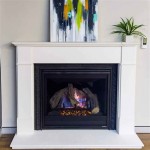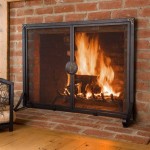How To Install Stacked Stone Veneer On A Fireplace
Installing stacked stone veneer on a fireplace can dramatically enhance its appearance, adding texture, depth, and a touch of natural elegance to the living space. This relatively straightforward project can be tackled by homeowners with moderate DIY skills, transforming a dull fireplace into a stunning focal point. The process involves careful planning, preparation, and execution to ensure a professional and long-lasting result. This article provides a comprehensive guide on how to install stacked stone veneer on a fireplace, covering essential steps, tools, and considerations.
Planning and Preparation
Before embarking on the installation process, thorough planning and preparation are crucial. This stage involves assessing the existing fireplace structure, selecting the appropriate stone veneer, gathering necessary tools and materials, and preparing the surface for the veneer. Neglecting these preliminary steps can lead to complications and potentially compromise the final outcome.
The first step is to inspect the existing fireplace. Note the material of the current facing. Is it brick, drywall, or something else? Knowing this will determine the necessary preparation steps. Measure the area to be covered in veneer. Accurate measurements are essential for calculating the amount of stone veneer required and avoiding material wastage or shortages. It's generally recommended to purchase approximately 10% more veneer than calculated to account for cuts, waste, and potential breakage.
Next, research and select the desired stacked stone veneer. Stacked stone veneer is available in various materials (natural stone, manufactured stone), styles, colors, and sizes. Select a veneer that complements the overall aesthetic of the room and meets the budget. Consider the weight of the veneer, as heavier stones may require additional structural support, especially for raised fireplaces or those with limited load-bearing capacity. Ensure the chosen veneer is suitable for fireplace applications, as some materials may not be heat-resistant or comply with local building codes.
Gather all the necessary tools and materials. This typically includes: a level, measuring tape, pencil, notched trowel (size determined by veneer manufacturer), thin-set mortar (specific type recommended by veneer manufacturer), wet saw with a diamond blade (for cutting the stone), safety glasses, work gloves, a mixing bucket, a mixing paddle (for use with a drill), a margin trowel or putty knife, a grout sponge, a wire brush, and sealant (if required by the veneer type). Ensure all tools are in good working condition before starting the project.
Proper surface preparation is paramount to ensure the veneer adheres correctly and securely. Remove any existing loose paint, wallpaper, or debris from the fireplace surface. Clean the surface thoroughly with a degreaser or TSP (trisodium phosphate) to remove any grease or oil residue that could hinder adhesion. If the existing surface is smooth (such as painted drywall or smooth concrete), roughen it by scoring it with a utility knife or sanding it with coarse-grit sandpaper to provide a better bonding surface. For particularly slick surfaces, consider applying a bonding agent or primer specifically designed for use with thin-set mortar.
If the fireplace is constructed of wood or a material that is combustible, it's crucial to install a non-combustible substrate, such as cement board, before applying the veneer. Cement board provides a fire-resistant barrier and a suitable surface for the mortar to adhere to. Attach the cement board to the fireplace structure using screws designed for that purpose, ensuring it is flush and securely fastened.
Applying the Stacked Stone Veneer
With the planning and preparation complete, the next phase involves applying the stacked stone veneer. This process requires careful attention to detail, ensuring proper alignment, spacing, and adhesion of the stones. Take your time and work meticulously to achieve a professional-looking result.
Begin by mixing the thin-set mortar according to the manufacturer's instructions. Typically, this involves adding water to the dry mortar mix and blending it thoroughly with a mixing paddle attached to a drill until a smooth, creamy consistency is achieved. Avoid adding too much water, as this can weaken the mortar's bonding strength. It should be thick enough to hold its shape when troweled but still pliable enough to work with.
Using the notched trowel, apply a layer of thin-set mortar to the prepared fireplace surface. The thickness of the mortar layer should be determined by the veneer manufacturer's recommendations, as different veneers may require different mortar thicknesses for optimal adhesion. Apply the mortar in small sections at a time, working from the bottom up. This prevents the mortar from drying out before the stones can be applied.
Select the first stone veneer piece and apply a layer of thin-set mortar to its back using a margin trowel or putty knife. Ensure the entire back surface is covered with mortar, paying particular attention to the edges. This creates a strong bond between the stone and the substrate. Press the stone firmly into the mortar on the fireplace surface, wiggling it slightly to ensure good contact. Maintain a consistent joint width between the stones, typically around 1/2 inch, unless a different joint width is specified by the veneer manufacturer or desired for aesthetic purposes. Use shims or spacers to maintain consistent joint widths.
Continue applying the stacked stone veneer, working in rows from the bottom up. Stagger the joints between the stones to create a more natural and visually appealing pattern. This also helps to distribute the weight of the veneer more evenly. Use the level to ensure the rows are straight and plumb. If the veneer pieces need to be cut to fit around corners or edges, use the wet saw with a diamond blade. Wear safety glasses and gloves when using the wet saw to protect yourself from debris and sharp edges.
Periodically check the alignment and spacing of the stones to ensure they are consistent and visually appealing. Use a damp sponge to wipe away any excess mortar that squeezes out from between the stones. This prevents the mortar from hardening on the surface of the veneer and making it difficult to remove later. Allow the mortar to dry completely according to the manufacturer's instructions before proceeding to the next step. This typically takes 24-48 hours, depending on the temperature and humidity.
Finishing Touches and Sealing
After the thin-set mortar has fully cured, the final steps involve addressing the joints between the stones and applying a sealant (if required) to protect the veneer and enhance its appearance. These finishing touches contribute significantly to the overall aesthetic and longevity of the installation.
Examine the joints between the stones. Some stacked stone veneer installations require grouting, while others are designed with tight joints that do not require grout. If grouting is required, select a grout color that complements the stone veneer and the overall design scheme. Mix the grout according to the manufacturer's instructions and apply it to the joints using a grout float. Work the grout into the joints thoroughly, ensuring they are completely filled. Remove any excess grout from the surface of the veneer with a damp sponge before it hardens. Follow the manufacturer's instructions for curing the grout.
If the stacked stone veneer is not grouted, or after the grout has fully cured, clean the surface of the veneer thoroughly with a wire brush to remove any remaining mortar residue or debris. This will enhance the natural texture and color of the stone. Be careful not to damage the veneer during the cleaning process. Wipe down the entire surface with a clean, damp sponge.
Depending on the type of stacked stone veneer and the desired aesthetic, a sealant may be applied to protect the veneer from moisture, stains, and other environmental factors. Check the veneer manufacturer's recommendations to determine if sealing is necessary or beneficial. If sealing is recommended, select a sealant specifically designed for use with stone veneer and follow the manufacturer's instructions for application. Apply the sealant evenly to the entire surface of the veneer, ensuring all areas are covered. Allow the sealant to dry completely before exposing the veneer to moisture or heavy use.
Inspect the completed installation thoroughly to ensure all stones are securely adhered, the joints are consistent, and the surface is clean and sealed (if required). Make any necessary touch-ups to address any imperfections or areas that may have been overlooked. Once satisfied with the final result, admire the transformed fireplace and enjoy the added beauty and warmth it brings to the living space.

How To Install Stacked Stone Tile On A Fireplace Thrifty Decor Diy And Organizing

How To Install Stacked Stone Tile On A Fireplace Thrifty Decor Diy And Organizing

How To Install Stacked Stone Tile On A Fireplace Thrifty Decor Diy And Organizing

Thin Stone Veneers Make A Fireplace Update Easy Swenson Granite 100 Natural Stones

How To Install Stacked Stone Tile On A Fireplace Thrifty Decor Diy And Organizing

How To Install Faux Stone Veneer Lowe S

Installing Fireplace Stone Ledgestone By Realstone System

How To Install Stacked Stone Veneer Wall Tiles

Tips On How To Build A Stone Fireplace Horizon

How To Install Stacked Stone Veneer Wall Tiles








